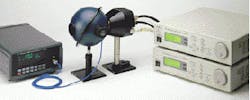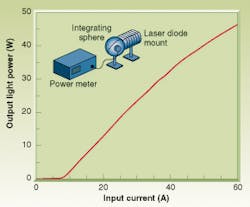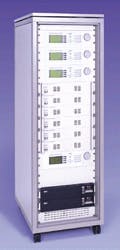POWER SUPPLIES: Specialized systems characterize laser diodes
Device sensitivity to temperature, current, and voltage must be accounted for when designing laser-diode test setups.
Kamran S. Mobarhan
Innovations are being made in laser-diode technology every day at laboratories and research centers around the world. With a rapidly growing market (more than $3 billion in 1999; see Laser Focus World, Feb. 2000, p. 70), an increasing number of companies are finding it attractive to join the ranks of laser-diode manufacturers. Most have either their own R&D division or strategic relationships with other groups that perform a variety of laser-diode research and development work.
In either case, a well-established laser-diode test-and-measurement facility that can accurately characterize the devices is a necessity. This facility could be at the research-and-development, prototype-manufacturing, high-volume production, or quality-control phase of the operation.
Testing high-power laser diodes
The testing of laser diodes essentially requires pumping electrical current into the device and measuring the optical characteristics of resulting emission. The primary parameters of interest are usually the absolute optical power level, as well as the spatial and spectral characteristics of the beam.
FIGURE 1. Test setup for characterization of high-power laser-diode bars includes laser-diode driver, temperature controller, water-cooled mount with thermoelectric cooler, integrating-sphere optical-power measurement system (Newport Model 819S-OPT-06-SL-CM-DV), and optical power meter (Newport Model 1835-C), which, during normal operation, would be completely enclosed for safety purposes. Instrument control and data acquisition are performed using a general-purpose interface bus and a computer (top). This experimental setup generates a plot of output optical power versus input current for a high-power laser-diode bar emitting at a peak wavelength of 808 nm (bottom).
Traditional power supplies cannot be used for driving a laser diode. Slight variations in the bias voltage will produce relatively large fluctuations in the current, which causes instability and may damage the device. It is, therefore, necessary to use a current source and not a voltage source to drive a laser diode. A typical voltage source does not offer the level of current control required for safe and reliable operation of a laser diode. Some of the current-source requirements include low noise, slow turn-on and turn-off, circuits protecting against voltage and current transients, automatic shorting, and high resolution.
In addition, in most applications laser diodes must be operated at precisely controlled temperatures. Even slight variations will change the emission wavelength, with undesirable results. Hence, laser diodes often are mounted onto heat sinks for effective heat dissipation and are cooled by thermoelectric coolers (TECs). Such coolers are typically driven by controllers that monitor the device temperature and that adjust the cooler to maintain the heat sink at a constant temperature. This is particularly crucial for laser diodes operating at high optical output powers (several watts). Such devices will degrade rapidly if not cooled properly. Advanced techniques are required to mount the diodes onto heat sinks, and reliable temperature controllers (such as the Newport Model 3150) are required to power TECs used in these applications.
A water-cooled mount onto which the laser-diode bar can be attached is at the center of a typical benchtop experimental test setup for characterizing high-power laser-diode bars emitting 30 to 50 W (see Fig. 1). This mount is equipped with a TEC. A high-power laser diode may require input current of more than 65 A. For this purpose a high-power laser-diode driver should be used (Newport Model 5600). Both the temperature controller and diode driver are computer-controlled using a general-purpose interface bus (GPIB).
The setup also includes an integrating-sphere optical-power-measurement system. This equipment consists of a 6-in.-diameter integrating sphere equipped with a silicon detector calibrated to US National Institute of Standards and Technology traceable standards. The power is measured using an optical power meter, also equipped with a GPIB.
Telecommunication applications
Laser diodes used in telecommunications are typically operated at relatively low power levels and are fiber-pigtailed. They often are tested in an array for faster cycle times. In the case of laser diodes used in dense wavelength-division multiplexing, as well as two-dimensional vertical-cavity surface-emitting-laser arrays, modular controllers offer the best solution. These controllers provide several fully isolated bays that accept a wide variety of laser-diode drivers and temperature-controller modules (see Fig. 2).
FIGURE 2. Modular laser-diode controller (Newport Model 8008) characterizes fiber-pigtailed laser diodes for telecommunication. This controller can drive and control temperature for up to eight lasers. Sixteen devices can be operated simultaneously if temperature-control capability is not required.
The controller in Fig. 2 can accept up to eight laser-driver/temperature-controller combination modules, so a researcher can test eight devices simultaneously. Various modules can be mixed and matched in this instrument to offer maximum versatility and freedom of choice. A small-diameter, integrating-sphere optical detector (Newport Model 818-IS-1) is used with an optical-power meter (Newport Model 1835-C) to provide optical-power measurements.
High-channel-density systems
The modular-controller concept can be expanded to meet the higher channel densities necessary in characterization of large numbers of laser diodes in production facilities. Often manufacturers need to test their diodes when the devices are mounted onto submounts, prior to packaging. It is also necessary to burn-in the modules at the quality-control phase of the manufacturing operation to weed out those devices that do not meet the stringent quality demands imposed on these products.
FIGURE 3. High-density laser-diode burn-in and characterization system handles dozens of laser diodes.
For such high-volume test-and-measurement applications, it is possible to stack several 16- or 32-channel modular diode controllers in racks for efficient use of cleanroom or laboratory floor space. High-density laser-diode test and burn-in systems devices are commercially available.
With this approach, multiple-channel rack systems can accommodate up to thousands of channels with output currents from 25 mA to 6 A. It is also possible to have high-power rack systems with water-cooled fixtures for high-power laser bars. By selecting a variety of modules, these systems can be configured for burn-in, characterization, and environmental testing of laser diodes (see Fig. 3). They use a digital interface to communicate with a central system computer for fully automatic control of the device-characterization process as well as data collection and analysis. Advanced test data-management software is used to collect and store the generated device parameters in highly organized and easily retrievable databases.
KAMRAN S. MOBARHAN is marketing manager for technology and applications in the Fiber Optics & Photonics Division of Newport Corp., 1791 Deere Ave., Irvine, CA 92606; e-mail: [email protected].




